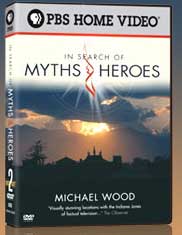In Search of Myths and Heroes
By Arundhuti Dasgupta | 16 Mar 2009
Written and presented by Michael Wood. Produced by Rebecca Dobbs.
A Maya Vision International production for BBC and PBS
Released: 3 February 2005
Distributed in India by: Saregama India Ltd
 The world of myth is usually construed as being part of an ageless age when the universe was strewn with fantastic creatures who spoke in indecipherable tongues. Alternatively it is categorised as a time when the gods walked the earth, creating life as we know it today. Whatever the perception, myths are rarely, if at all, seen as a part of the present. Michael Wood, in his book and television series (first shown in 2005 as a BBC/PBS programme and available as a DVD) called In search of myths and heroes challenges this perception by tracking the geographical, historical and philosophical roots of four big myths.
The world of myth is usually construed as being part of an ageless age when the universe was strewn with fantastic creatures who spoke in indecipherable tongues. Alternatively it is categorised as a time when the gods walked the earth, creating life as we know it today. Whatever the perception, myths are rarely, if at all, seen as a part of the present. Michael Wood, in his book and television series (first shown in 2005 as a BBC/PBS programme and available as a DVD) called In search of myths and heroes challenges this perception by tracking the geographical, historical and philosophical roots of four big myths.
Wood tracks four powerful myths: Queen of Sheba, Shangri La, The Golden Fleece and The Holy Grail. He digs into them like an archaeologist would drill into an ancient ruin or a doctor into a patient’s medical history, searching for clues and looking for a narrative thread that would tie our past to our present.
The search for the worlds captured in these myths takes Wood to some of the remotest corners of the world. He travels to Western Tibet, braving hostile weather conditions, rough terrain and political obstacles in search of Shangri La. He drives along the coasts of Ethiopia, Yemen and the Horn of Africa looking for the home of Queen of Sheba and the stories that deify her.
His journeys are illuminating not just for their revelation of little known facts and interesting references about the places and people associated with the myths but also because they trace an unmapped journey through the heart of humankind. For myths are more than stories or exaggerated accounts of historical and geographical events. They are tales of the sacred, tracing man’s experience with life, the world and its universal concerns about birth and death, good and evil and the afterlife. By tracing their origin and following the path set out in the stories handed down the years, Wood drives home the relevance of myth to our present day lives.
In his journeys Wood speaks to people, tells stories and listens to anecdotal evidence as well as that recorded in the holy books and puts it all together in a compelling story. And as he criss-crosses the world looking for the roots and branches of old myths, he shows us how these old stories unite us in the way they depict man’s experiences and reveal universal archetypes.
The episode about Queen of Sheba, a story that appears in Jewish, Christian and Muslim religious texts, features the archetype of the Great Mother who founds a civilisation. As the story goes, the queen is said to have travelled from Ethiopia or Yemen or both to Israel to meet King Solomon, of whose wisdom she has heard much praise. Her encounters with him lead the two to get close and the queen goes back to give birth to their son who is the first of a line of Ethiopian kings. In this myth Queen of Sheba has been characterised just like the great goddesses of creation such as Izanami (Japanese), Gaia (Greek) and Isis (Egypt). These goddesses or women of power needed a mate who could equal their stature and wisdom and went looking for one. Their union led to the formation of the world and in the Queen of Sheba myth, a nation and its line of kings.
Similarly in the episode about Shangri La, the archetype of paradise as a lost land is reinforced. As the website about the making of the series (http://www.pbs.org/mythsandheroes/myths.html) tells us, “These myths express hope that the paradise can be regained, either by finding its earthly location, or by waiting for a future time when mankind shall redeem itself.”
For Wood, every journey he undertakes is a revelation and although he says (in an interview on PBS) that his best experience was the journey to Shangri La, the series does not reveal his favourite. He is wonderfully awestruck by and diligent about the details for each for the four myths. It is this passionate pursuit of the mythical hero, place and symbol in his story that makes every episode special for the viewer and the DVD, a collector’s item.